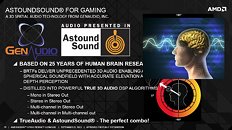Thursday, September 26th 2013

Do We Really Need AMD TrueAudio?
At its press meet called to unveil its next-generation graphics lineup, which lasted for about 3 hours and 45 minutes, a full one hour was spent detailing TrueAudio, an audio DSP that AMD co-developed with GenAudio, makers of AstoundSound technology; both of which are brand names we'd heard for the first time, and that's coming from someone who's been an audiophile and follower of PC audio technology for 15 years now. Here are a few reasons why the concept of TrueAudio, or at least the way AMD and its newfound GenAudio pals explained it, is unconvincing to the extant of flagging "snake oil." While we did not attend GPU'14, experiencing TrueAudio is irrelevant to our analysis. It focuses on what "yet another" positional audio DSP has to do with GPU, and how AMD is getting ahead of itself with non-graphics features in exactly the same way it criticized NVIDIA of doing, not too long ago.Back in the 1990s and the first half of the previous decade, discrete sound cards were an integral component of any self-respecting gaming PC, as onboard audio solutions were either too basic (ISA-based CODECs, USB-based AC'97) or sounded like greeting cards. Apart from higher fidelity, discrete sound cards offered proprietary positional-audio and DSP layers, promised hundreds of hardware-mixed audio voices, and what have you. AMD, in its presentation, didn't succeed in explaining how its solution is any different from something Dolby, Yamaha, Creative, ESS, and others haven't already tried.
With Intel's Azalia specification, and acceptable increments in audio fidelity past the 85 dBA signal-to-noise ratio mark with most motherboard-integrated audio solutions, game engine developers spent the better part of last decade innovating positional- and immersive- audio technologies that didn't require specialized hardware. You get the same incredible sound-effects on Battlefield 3 on any hardware, with discrete sound cards only offering better audio quality, but not better effects (positional- or realism). In that respect, we feel that it's quite arrogant of AMD to claim that there has been no innovation in PC game audio since programmable shaders (2001-02). To the contrary, game engine developers like Unreal, CryTek, DICE, etc., worked tirelessly to make effects comparable to three-figure discrete sound cards accessible to all gamers, by leveraging multi-core/multi-threaded CPUs.
What AMD didn't explain to us, is whether use of TrueAudio technology requires Radeon graphics cards to be installed; because if it does, then there's little difference between AMD's approach to positional-audio, and discrete sound card manufacturers', which unsuccessfully tried to make people to buy their sound cards on the "better audio immersion" plank, before switching over to the "better audio quality" plank, upon realizing that "better immersion" doesn't sell sound cards anymore.
What AMD also didn't explain is where "Radeon" fits into all this. It's a GPU alright, and combined with OpenCL, it's capable of general-purpose computing. It didn't explain whether the TrueAudio DSP layer runs on the CPU, or is something the GPU spares some of its computing power on. We're not convinced by the "hear more voices in a game" claim. The way audio is implemented on Windows, an application can stream up to 65,535 "voices" (independent streams of digital audio through a software/inter-process-communication channel), which are then mixed into "what you hear." So the only way AMD can sell "hear more voices," is if it gives developers something that can let them stream those hundreds of voices, while minimizing the CPU cost of processing and mixing them. If not having those many voices in any way steps beyond being just aesthetics (think crowds in a games like Assassins Creed, GTA), and actually affects the gameplay (i.e. not hearing all those voices puts you at a disadvantage in, say, an online multiplayer shooter), then you can bet your bottom penny that developers won't implement it.
In conclusion, even if TrueAudio made genuine improvements in the accuracy of positional audio, which they claim is backed by "25 years of brain research," there are too many factors stacked up against its successful proliferation. Want better sound? Go get a nice sound card and/or better speakers/headsets. Don't count on dinosaur DSPs anymore. There are two components to better game audio, "immersion" and "output quality." Your game developer already took care of the "immersion" part, and today's premium sound cards and speakers/headsets look after "output quality." Not much room for AMD to squeeze into this neat little arrangement.
With Intel's Azalia specification, and acceptable increments in audio fidelity past the 85 dBA signal-to-noise ratio mark with most motherboard-integrated audio solutions, game engine developers spent the better part of last decade innovating positional- and immersive- audio technologies that didn't require specialized hardware. You get the same incredible sound-effects on Battlefield 3 on any hardware, with discrete sound cards only offering better audio quality, but not better effects (positional- or realism). In that respect, we feel that it's quite arrogant of AMD to claim that there has been no innovation in PC game audio since programmable shaders (2001-02). To the contrary, game engine developers like Unreal, CryTek, DICE, etc., worked tirelessly to make effects comparable to three-figure discrete sound cards accessible to all gamers, by leveraging multi-core/multi-threaded CPUs.
What AMD didn't explain to us, is whether use of TrueAudio technology requires Radeon graphics cards to be installed; because if it does, then there's little difference between AMD's approach to positional-audio, and discrete sound card manufacturers', which unsuccessfully tried to make people to buy their sound cards on the "better audio immersion" plank, before switching over to the "better audio quality" plank, upon realizing that "better immersion" doesn't sell sound cards anymore.
What AMD also didn't explain is where "Radeon" fits into all this. It's a GPU alright, and combined with OpenCL, it's capable of general-purpose computing. It didn't explain whether the TrueAudio DSP layer runs on the CPU, or is something the GPU spares some of its computing power on. We're not convinced by the "hear more voices in a game" claim. The way audio is implemented on Windows, an application can stream up to 65,535 "voices" (independent streams of digital audio through a software/inter-process-communication channel), which are then mixed into "what you hear." So the only way AMD can sell "hear more voices," is if it gives developers something that can let them stream those hundreds of voices, while minimizing the CPU cost of processing and mixing them. If not having those many voices in any way steps beyond being just aesthetics (think crowds in a games like Assassins Creed, GTA), and actually affects the gameplay (i.e. not hearing all those voices puts you at a disadvantage in, say, an online multiplayer shooter), then you can bet your bottom penny that developers won't implement it.
In conclusion, even if TrueAudio made genuine improvements in the accuracy of positional audio, which they claim is backed by "25 years of brain research," there are too many factors stacked up against its successful proliferation. Want better sound? Go get a nice sound card and/or better speakers/headsets. Don't count on dinosaur DSPs anymore. There are two components to better game audio, "immersion" and "output quality." Your game developer already took care of the "immersion" part, and today's premium sound cards and speakers/headsets look after "output quality." Not much room for AMD to squeeze into this neat little arrangement.



87 Comments on Do We Really Need AMD TrueAudio?
I don't need to hear about it for 3 of the 4 hours of a VIDEO CARD release.
Just a bunch of marketing BS.
Sorry for the use of redundant terms there....marketing....BS....same things.
Realtek used to do positional audio but the last 2 mobo's ( in specs ) fail to deliver positional audio.
positional audio is very useful in games like arma never mind a lot of others most part for games were you can free roam and have the chance of some thing being behind you. As not knowing if that tank is down that hill or not is a killer as it could be at ya rear without positional audio.
With the current realtek on my mobo's at least you can tell left to right to a point but you cannot tell if it's in front or behind you.
I m all up for improvements but my actually main complaint is HDMI it's self and the lack of channels with only supporting 8 on this gen and the next release of HDMI is only going support 16. If this is a separate device from the graphics card that bee interesting although as i said their cards already have positional audio.
As long as it works as well or better i be happy.
The question that needs to be answered is how viable is TrueAudio. If it works well, then it is another selling point for a graphics card which people would have pondered over regardless.
To OP, Yes....
Pc game audio is a bit shit with or without an add in card especially compared to consoles connected to decent audio gear.
I cannot for the life of me see any problem or issue Anyone might have with the Option to use better audio codecs etc i doubt it has to be used anyway mearly an option for devs and users.
choice be good , stop denigrating it:wtf:
I would call this the absolute guy mistake. So how you call the place where you live?
Anyway, I have no idea about any of this, except Thief.
Wow.
By the way, I've had some corsair 1500 headphones that do 7.1 audio for about 2 years now. I can hear in front of me, behind, above, below, etc. And usually headed towards enemy before other players are.
Ultimately, I think AMD is just trying to get developers and consumers to move away from Intel as the "choice" for processing and more towards AMD GPUs and APUs.
I'll have no problems playing the dogfighting module on low-ish settings. Low settings look better than most other games maxed out anyways.
I had in mind dead space though, it had some cool sound effects from what I remember.
I don't agree with their argument of the need to offload audio processing from the CPU. GPUs are rarely less than 100% utilized in games, while it's much more difficult to thread a game properly to reach 100% CPU utilization. Why not use those spare CPU cycles to process audio and let the GPU run at 100% load processing graphics?
If so my maximus had it (775 socket ) and that did it too so i would not be surprised if the optical from the SupremeFX X-Fi 2 did positional audio correctly.
One thing is though their cards already have it so why are they only bringing it up now like if it was not there in the 1st place lol.
And Free LOL, nothings FREE. It's one reason i will opt for a ATI before a nVidia card. I have used positional audio in my games for so many years now just that many don't realize they can have it or not in to such things. And optical output used to be a given for positional audio even back when i had my ABit mobo with a 3800x2.
And to be honest i don't care about consoles and if they have it or not no good to me as seen as most only have 2-4 games that i will play on them in there life time.